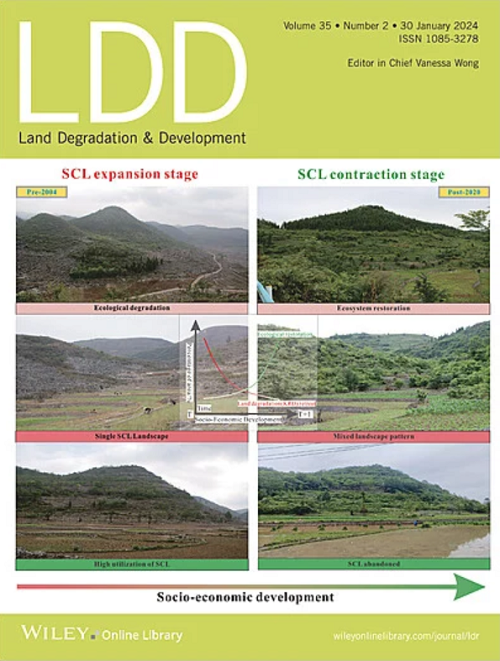Soil Quality Indicators and Machine Learning to Assess Iron Mining Waste Piles Revegetation in the Eastern Amazon
IF 3.6
2区 农林科学
Q2 ENVIRONMENTAL SCIENCES
引用次数: 0
Abstract
In the eastern Brazilian Amazon, iron mining significantly impacts the environment. This study evaluated soil recovery in revegetated mining waste piles in the Carajás Mineral Province, focusing on chemical, physical, and biological indicators. Revegetation stages (0–2, 3–5, 6–8, and 9–11 years) were evaluated and compared to native tropical forest reference soils over 4 years, during the dry season. After 9–11 years, soil organic carbon (SOC), microbial biomass carbon (MBC), and enzymatic activity in revegetated soils reached levels similar to reference conditions. In early stages (0–2 years), microbial carbon was a key component, but from year 3 onward, plant‐derived organic material likely contributed to increased SOC. Distance‐based redundancy analysis showed significant temporal differences in microbial variables (土壤质量指标和机器学习评估东亚马逊地区铁矿废渣堆植被
在巴西东部亚马逊地区,铁矿开采对环境的影响很大。本研究以化学、物理和生物指标为重点,评价了Carajás矿产省矿山废弃地复植后的土壤恢复情况。在旱季期间,对植被恢复阶段(0-2年、3-5年、6-8年和9-11年)进行了评估,并与4年的原生热带森林参考土壤进行了比较。植被恢复后9 ~ 11年,土壤有机碳(SOC)、微生物生物量碳(MBC)和酶活性达到与对照条件相近的水平。在早期阶段(0-2年),微生物碳是关键组成部分,但从第3年开始,植物来源的有机物质可能有助于增加有机碳。基于距离的冗余分析显示,微生物变量的时间差异显著(p <;0.001), SOC、Al3+、Mn、Ca2+、pH (CaCl2)和土壤质地驱动了这些变化。随机森林模型对土壤恢复阶段关键指标的预测效果较好,模型总体精度(Overall Accuracy, OA) = 0.80, Cohen’s Kappa系数(Cohen’s Kappa coefficient, CKC) = 0.74,预测精度较高。关键预测变量包括β - 1,4 -葡萄糖苷酶、MBC、粘土含量、铁和SOC。虽然研究结果表明,植被恢复改善了土壤质量和碳动态,但局限性包括仅限于旱季的采样以及采矿废料和气候条件的潜在变异性。尽管如此,这项研究强调了将土壤质量指标与机器学习相结合以支持热带环境中可持续土地管理的重要性,正如东亚马逊地区采矿废渣堆的植被所示。
本文章由计算机程序翻译,如有差异,请以英文原文为准。
求助全文
约1分钟内获得全文
求助全文
来源期刊

Land Degradation & Development
农林科学-环境科学
CiteScore
7.70
自引率
8.50%
发文量
379
审稿时长
5.5 months
期刊介绍:
Land Degradation & Development is an international journal which seeks to promote rational study of the recognition, monitoring, control and rehabilitation of degradation in terrestrial environments. The journal focuses on:
- what land degradation is;
- what causes land degradation;
- the impacts of land degradation
- the scale of land degradation;
- the history, current status or future trends of land degradation;
- avoidance, mitigation and control of land degradation;
- remedial actions to rehabilitate or restore degraded land;
- sustainable land management.
 求助内容:
求助内容: 应助结果提醒方式:
应助结果提醒方式:


